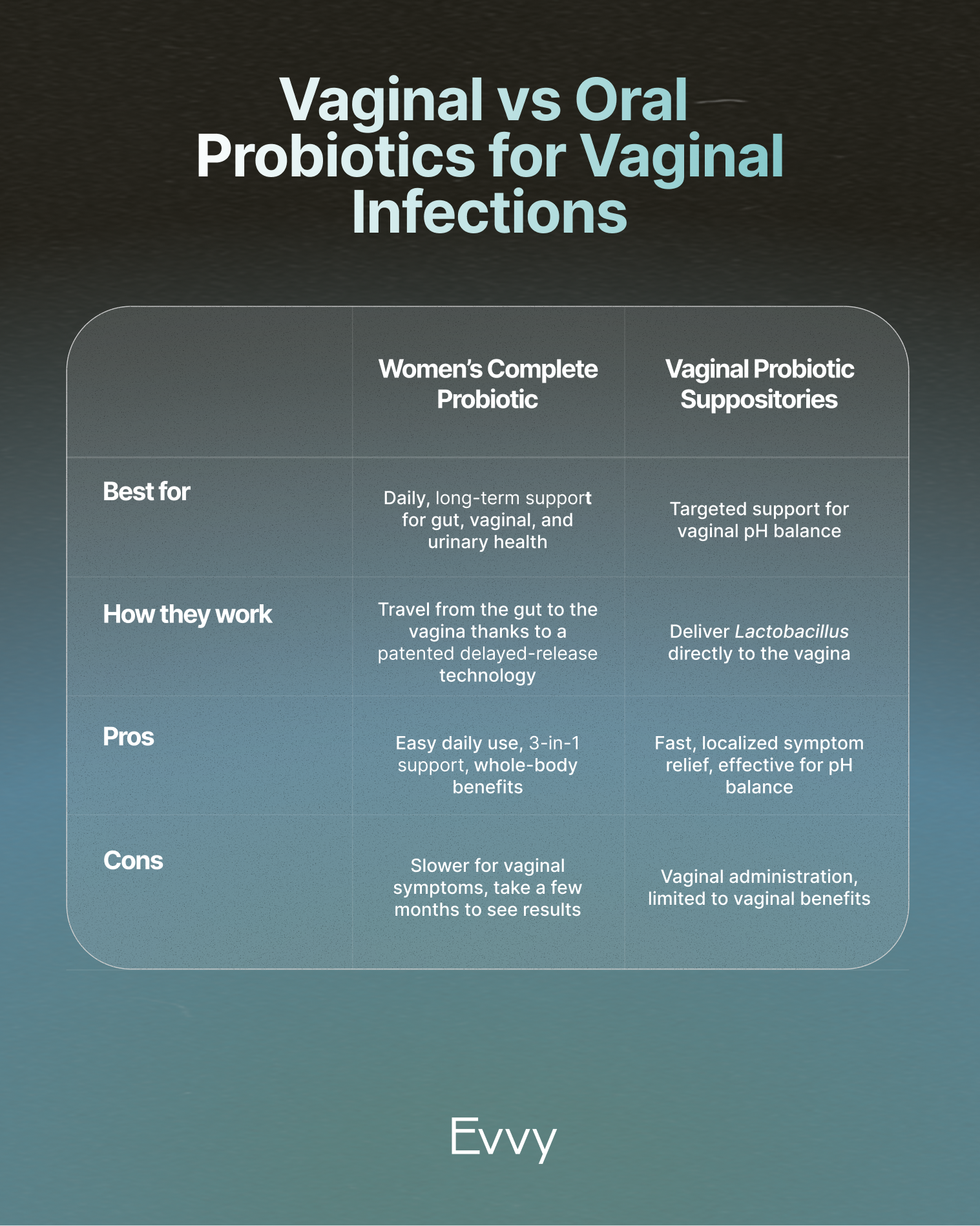

Vaginal vs Oral Probiotics: How to Choose What’s Right for You
Discover how to choose between vaginal and oral probiotics for BV, yeast infections, and daily support. Explore pros and cons, and Evvy solutions.
Words by Olivia Cassano
Scientifically edited by Dr. Krystal Thomas-White, PhD
Medically reviewed by Dr. Kate McLean MD, MPH, FACOG
Vaginal infections like bacterial vaginosis (BV) and yeast infections are extremely common, but for some people, they don’t just come and go. Depending on your lifestyle, overall health, and the unique makeup of your vaginal microbiome (called your Community State Type, or CST), you may be more prone to prolonged or recurrent imbalance, also known as vaginal dysbiosis.
The standard first-line treatments for bacterial vaginosis and yeast infections are antibiotics or antifungals. While very effective at killing harmful microorganisms, frequent use can also wipe out beneficial bacteria, leaving your vaginal microbiome more fragile and making it easier for disruptive bacteria to return.
That’s where probiotics come in. Probiotics aim to replenish the good bacteria that naturally defend your vagina. Both oral and vaginal probiotics can help restore balance, but they work in different ways. So how do you know which is right for you, and when? Let’s dive in and learn how to choose between vaginal and oral probiotics.
How do probiotics help vaginal health?
Your vagina has its own unique microbiome, a dynamic community of bacteria and fungi that shifts in response to factors such as sex, hormones, menstruation, medications, and stress. A healthy vaginal microbiome is dominated by protective Lactobacillus species, which help maintain a low (acidic) pH. This acidity makes it harder for harmful microbes to thrive.
Probiotics support vaginal health by encouraging the growth of healthy bacteria, specifically, Lactobacilli. These microbes can attach to the vaginal walls, essentially taking up space so there’s less room for disruptive bacteria or yeast to thrive. They also help regulate pH by producing lactic acid, which keeps the vaginal environment acidic and less hospitable to unwanted invaders. On top of that, certain strains are capable of producing antimicrobial compounds that directly inhibit or kill harmful microbes nearby. Together, these actions help restore and maintain the natural balance of the vaginal microbiome.
Not all probiotics are equal, though: the strains matter. Research suggests that Lactobacillus rhamnosus GR-1, Lactobacillus reuteri RC-14, and Lactobacillus crispatus are especially effective in promoting balance. Evidence also shows probiotics may be helpful when taken alongside antibiotic treatment for BV, or antifungal treatment for yeast infections.

Recurrent symptoms? Get Evvy's at-home vaginal microbiome test, designed by leading OB-GYNs.
Oral probiotics
Oral probiotics are supplements containing live good bacteria that you swallow, most often in capsule form, to support your body’s internal microbial ecosystems. They’re designed to be taken daily and primarily target the gut microbiome, but some (like Evvy Women’s Complete Probiotic) can also influence vaginal and urinary health because these systems are closely interconnected.
How oral probiotics work
After you swallow a capsule, probiotic bacteria make their way through your digestive tract. If formulated correctly, some survive stomach acid and colonize the gut, where they support digestion and immune function. While certain strains may migrate to the vagina and urinary tract, this does not always happen. But colonization in the gut can also have downstream benefits in the vagina (via the gut-vagina axis), which promotes health across these systems.
While not all strains are shown to promote vaginal health, the right combination can support long-term resilience. Research shows that certain probiotic strains, especially Lactobacillus rhamnosus GR-1 and Lactobacillus reuteri RC-14, help promote vaginal health.
Benefits & limitations
Pros:
- Easy to take daily
- Some can support gut, urinary, and vaginal health simultaneously
- Help maintain balance even when you’re not experiencing symptoms
- Can reduce bloating and improve digestion.
Cons:
- Take longer to impact the vaginal microbiome directly
- Consistency is key, so it might take a few months to notice benefits
- Effectiveness depends on strain selection and delivery technology
- Not as ideal for fast, targeted relief of vaginal symptoms.
Vaginal probiotic suppositories
Unlike oral supplements, vaginal probiotics are inserted directly into the vagina (and not designed to be swallowed). This localized approach is particularly useful when you want targeted support, for example, after a round of vaginal antibiotics, after your period, or when recovering from a vaginal infection.
How vaginal probiotics work
When inserted into the vagina, probiotic suppositories release beneficial Lactobacillus strains that colonize the vaginal walls. These bacteria produce lactic acid and hydrogen peroxide, helping to lower vaginal pH and crowd out disruptive microbes.
Evvy’s Vaginal Probiotic Suppositories also contain lactoferrin, a natural antimicrobial protein that further inhibits unwanted bacteria and yeast.
Benefits & limitations
Pros:
- Directly delivers protective bacteria to the vagina, which increases the chances of restoring balance and improving symptoms
- Ideal for targeted, occasional support
- Doesn’t need to be taken daily
- Clinically-studied strains shown to colonize the vagina.
Cons:
- Support vaginal health only (not gut or urinary systems)
- Some people may find vaginal application uncomfortable or impractical
- Effects may fade if underlying triggers aren’t managed.
How to choose based on your needs
So, should you go with oral probiotics supplements, vaginal suppositories, or both? It depends on your needs. If you want daily, full-body microbiome support, an oral probiotic is your best bet. This is especially true if you also deal with bloating, urinary tract infections, or want proactive care for vaginal balance.
Evvy Women’s Complete Probiotic is formulated with clinically-studied strains (L. Reuteri RC-14®, L. Rhamnosus GR-1®, L. crispatus, L. acidophilus, and L. plantarum) plus added vitamins and postbiotics for true 3-in-1 microbiome support.
If you’re looking for targeted support after disruptions or during recovery from an infection, vaginal suppositories can help restore balance more directly and quickly. Evvy’s Vaginal Probiotic Suppositories combine multiple strains of clinically-studied Lactobacillus with lactoferrin for prescription-grade, targeted relief. They’re perfect for after your period, sex, or antibiotics, or whenever your vaginal microbiome needs a boost.
Many people use both together: a daily oral probiotic for long-term balance, paired with vaginal suppositories as needed for extra support.

FAQs about oral and vaginal probiotics
Are vaginal probiotic suppositories more effective than oral probiotics?
Not necessarily, they simply work in different ways. Vaginal suppositories provide a direct and localized approach, delivering Lactobacillus bacteria right to the vagina. This can increase the chances of changing the microbiome and improving symptoms like vaginal odor and unusual vaginal discharge. Oral probiotic supplements, on the other hand, work through the gut-vagina connection and may take longer to show benefits. However, they support overall balance across the gut, vaginal, and urinary systems. The “best” option depends on your goals: quick symptom relief, long-term maintenance, or both.
Can I use oral and vaginal probiotics together?
Yes, and many people do. Oral probiotics are ideal for daily use, supporting your gut, urinary, and vaginal microbiomes holistically. Vaginal probiotic supplements are best for occasional, targeted support after common disruptions like antibiotics or your period. Together, they provide a layered approach: the oral probiotic builds resilience over time, while the vaginal probiotic acts as a reset button when you need it most. Using them in combination is safe and often recommended for people with recurrent infections.
What do vaginal probiotics do?
Vaginal probiotics deliver protective Lactobacillus strains directly into the vagina. These bacteria help restore balance by lowering pH, producing antimicrobial compounds, and physically crowding out harmful microbes. By supporting a healthy Lactobacillus-dominated environment, they can reduce the risk of infections like bacterial vaginosis or yeast overgrowth. Some formulas, like Evvy’s Vaginal Probiotic Suppositories, also include lactoferrin, a natural antimicrobial that works alongside probiotics to keep disruptive bacteria and yeast in check. Think of vaginal probiotics as a targeted tool to rebalance your vaginal microbiome when it’s under stress.
How long do vaginal probiotics take to work?
The timeline varies, but many people notice improvements in odor, vaginal discharge, or comfort within a few days of starting vaginal probiotics. That said, results depend on your body, your starting microbiome, the strains used, and whether there are ongoing triggers (like antibiotics or hormonal changes). For best results, they’re often used as part of a maintenance routine, for example, after having sex, getting your period, or finishing a course of antibiotics. Using vaginal probiotics regularly during vulnerable times can help prevent symptoms from returning.
What is the best probiotic for BV?
Bacterial vaginosis is most often associated with an overgrowth of anaerobic bacteria and a lack of protective Lactobacillus in the vagina. Research shows that L. rhamnosus is among the most effective strains for preventing bacterial vaginosis recurrence (alongside standard bacterial vaginosis treatment). Some studies suggest that combining antibiotics with probiotics leads to longer-lasting relief than antibiotics alone. While more research is needed, products like Evvy’s Women’s Complete Probiotic and Vaginal Probiotic Suppositories contain clinically-studied strains that may support recovery and help reduce the chances of bacterial vaginosis coming back. While probiotics alone aren't effective in treating bacterial vaginosis, it’s worth asking your doctor about pairing probiotics with medical treatment if bacterial vaginosis is a recurring issue.
Can oral probiotics help with yeast infections?
Yes, but mostly as part of a long-term strategy. Oral probiotics with certain Lactobacillus strains can help maintain vaginal balance and reduce the risk of yeast overgrowth. They do this by promoting a healthy vaginal pH and crowding out Candida, the fungus responsible for yeast infections. However, they’re not a quick fix if you’re in the middle of an active infection. Antifungal treatment or, in some cases, alternative therapies like boric acid are far more effective than probiotics at treating a yeast infection. Over time, though, both oral and vaginal probiotics may help prevent recurrent yeast infections by maintaining vaginal health (when used consistently).





